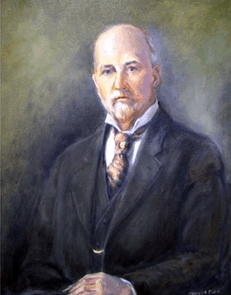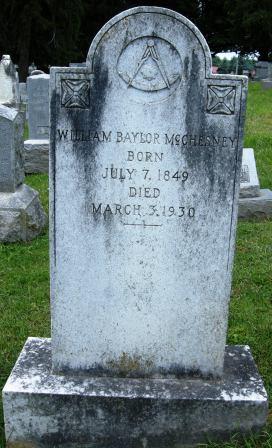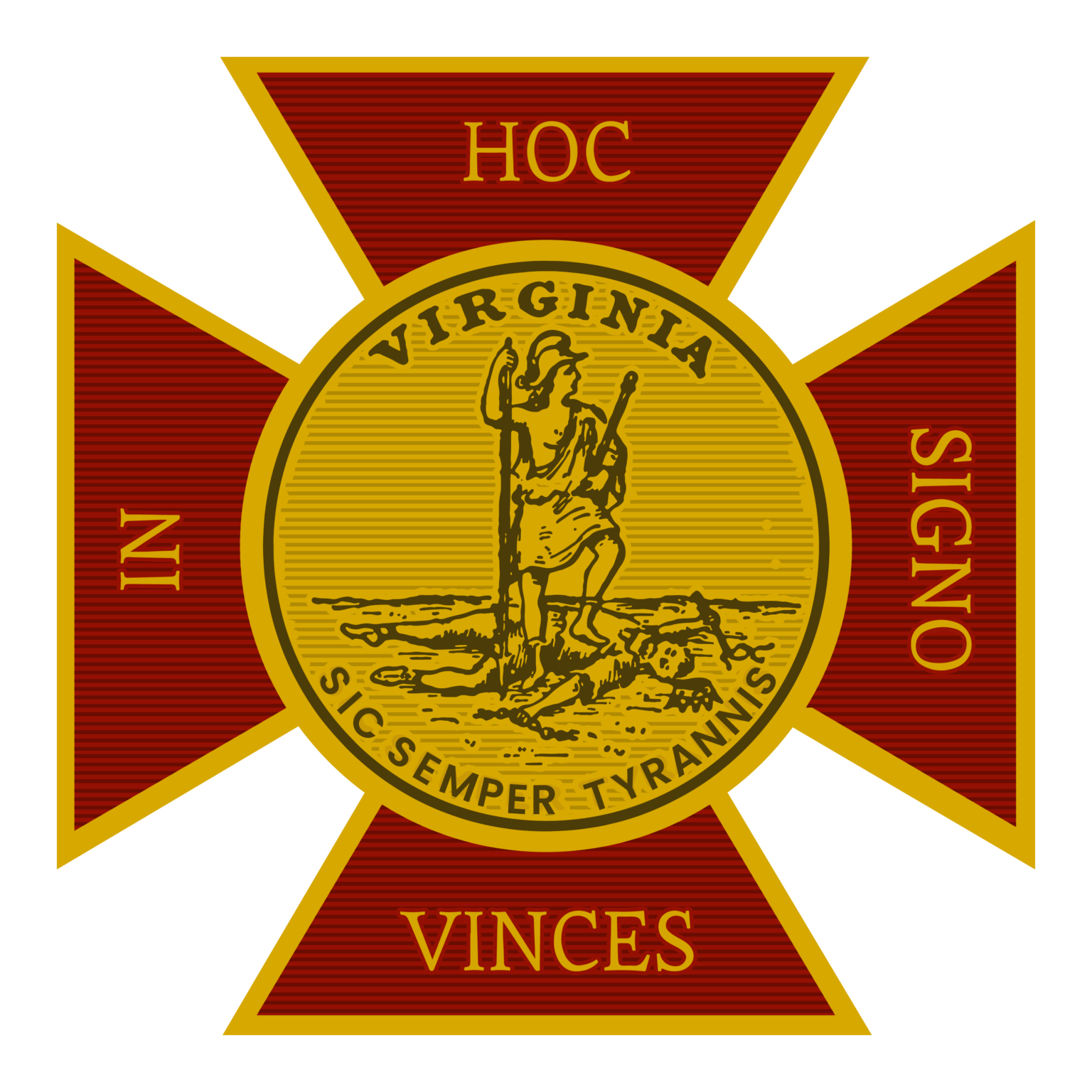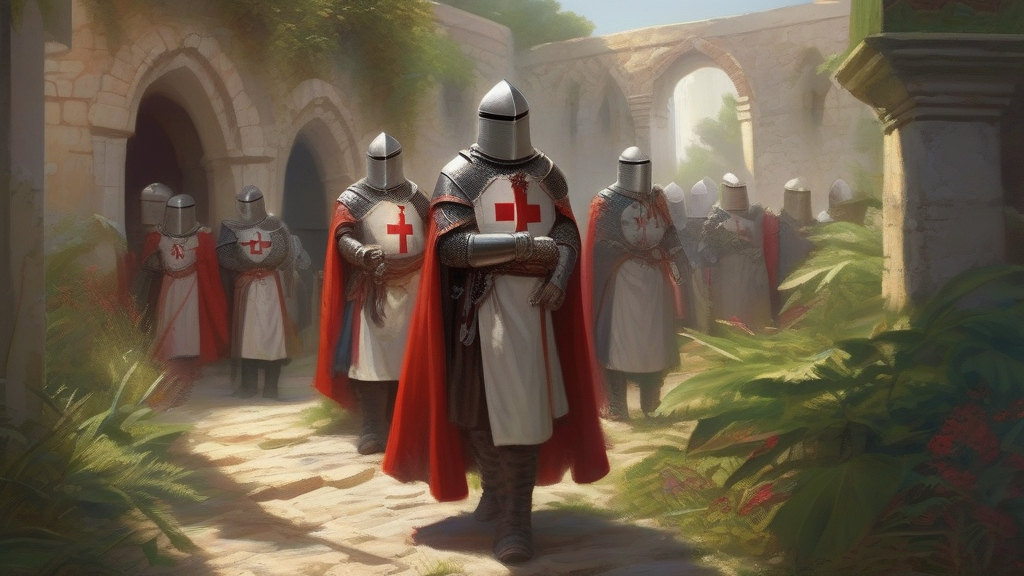William Baylor McChesney
Grand High Priest 1908, Grand Commander 1910-1911, Grand Master 1910-1911
William Baylor McChesney was one of the no less than a dozen men in Virginia, who presided over all three of Virginia’s grand bodies. His name is still remembered by a great number of Brethren in our own Blue Lodges, Chapters, and Commanderies. His love for the Fraternity, and mankind in general, made him well known among Men and Maison’s, thought Virginia.
William McChesney was born in Staunton, Virginia on July 7, 1849. At the age of 14, after the outbreak of the Civil War, he joined the 14th Virginia Cavalry in Churchville Virginia, with several of his relatives. He served until the end of the War and returned to Staunton to finish school. He attended Washington College in Lexington Virginia, where General Robert E. Lee was president of that institution where he made his proudest boast in the fact that he had served as a member of the honor guard at General Lee’s burial. Being a Confederate Army Veteran, he was naturally a man of great patriotic convictions.
He was raised in Rockingham Union No. 27 0n July 29, 1879, and moved to Aberdeen, South Dakota. Shortly thereafter, he returned to Staunton some years later in 1885, where he affiliated with all the Staunton Masonic Bodies. He was the Master of the Lodge in 1887-1889, and the Secretary from 1898-1918. In 1885 Brother McChesney was appointed to the committee to lay a cornerstone at the building of the monument to the Confederate Dead in Thornrose Cemetery, in Staunton. On June 9, 1885, at which all the other masonic bodies were largely represented at the laying of the cornerstone. In 1889 while serving as Master of Staunton No. 13, Brother McChesney and the other members voted to purchase the property which would become the Masonic Hall for years to come, located at 13 Beverly Street in Staunton. Under the direction of William H. H. Lynn, Master of the Lodge, Brother McChesney was appointed to the building committee, where the members bought Bonds to pay for the construction of the Masonic Hall. On its completion of the building on June 6, 1895, all the bonds were retired, and the building paid for in full. The cornerstone of the temple was laid by Staunton Lodge on June 6, 1895, and the stretcher was dedicated, and occupied the following year. The first three floors were to be rented. The fourth floor was the Chapter and Commandery rooms. The fifth floor was the spacious Lodge room for Staunton Lodge No. 13, and the adjacent banquet hall. The Eastern Star also met on the fifth floor.
Companion William B. McChesney was exalted in Rockingham Chapter No.6 in Harrisonburg in 1880, then resided in Aberdeen South Dakota, until relocating in Staunton in January of 1885 where he remained until the end of his days. In February 1885 he affiliated with Union Chapter No.2 RAM, were took an active part in degree work. In 1887 the Grand Chapter adopted a resolution to the effect, that the work in the Capitular degrees as exemplified by Grand Lecturer William H. H. Lynn was confirmed as the work of the Grand Chapter of Virginia and “that he be requested to teach the subordinate Chapters”. William Lynn was Past Grand High Priest of Virginia (1882-1883), Past High Priest of Union No.2, was gratifying to the Companions of Union No. 2. In 1888 William H. H. Lynn, J. Howard Wayt, Jacob Bumgardner, E. Louis Ide, and William B. McChesney all held offices in the Union Chapter. On October 16, 1891, William B. McChesney served as High Priest for the year. During his reign as High Priest the Chapter room was under construction on the fourth floor of the Staunton Masonic Temple, were he laid out the designs for the Chapter room. He also formed a committee to see about furnishing the Chapter for the future time when the building was to be completed.
In January 1869 Levi L. Stevenson, along with eight others (the minimum number permitted), petitioned the Grand Commandery of Virginia for a dispensation to form a new Commandery in Staunton. The Grand Commander John Robin McDaniel, of Lynchburg, issued the dispensation authorizing the opening of Stevenson Commandery. On May 11, 1869, the Charter of Stevenson Commandery No. 8 Knights Templar was issued. The Commandery started its career with a membership of nineteen knights.
The Commandery immediately became a sort of “institution” in Staunton just as were the Lodge and Chapter before it. The fact the War Between the States were still very much alive made the simi-military character of the Knights Templar appeal greatly to the people of the community generally. Written invitations for the Knights Templar to appear in full uniform on public occasions. One such occasion was Memorial Day in both Staunton and Charlottesville, on June 9, 1871. After the morning celebration in Staunton, they hoped for a train for Charlottesville for the afternoon service.
On June 9, 1885, was Memorial Day again and the Commandery was invited as usual to attend the exercises in full uniform. On this particular occasion the cornerstone to the Confederate dead in Staunton, was laid by Sir Knight William B. McChesney. William B. McChesney, who was Knighted in Harrisonburg Commandery No. 10, was elected a member of Stevenson Commandery. When the Grand Encampment of the United States met in Washington in 1890, Stevenson Commandery was represented by a considerable number of members, to include William B. McChesney Generalissimo. In 1891 to 1893 he was the Commander of Stevenson Commandery. Sir Knight McChesney at that time would go on to be the second Grand Commander of Knights Templar of Virginia (1910-1911) from Stevenson Commandery.
Grand High Priest (1908-1909)
In 1908 Most Excellent William Baylor McChesney was elected and installed the Grand High Priest in the Grand Chapter Royal Arch Masons of Virginia. In his address of the One Hundred and Second Grand Annual Convocation, much was spoken on the Schools of Instruction. He spoke highly of the Valley Royal Arch School, and the high state of work that was being done for Capitular Masonry in Virginia. Most Excellent McChesney believed in the ritual schools, and the returns to the Companions, was well worth the effort. In an address to the Companions the Grand High Priest said, “Men in all ages have sought to erect monuments”—let us determine that we will make of this institution a monument that will be a source of pride, not only to the present generation, but to those that are to follow; to nourish, to support and to patronize until it shall be said of us that we are known for our “good works”.
In 1909 there were 64 Chapters on record. The number of Royal Arch Masons reported in 1908 was 5564. In 1909 there were 498 Exalted, 81 Affiliated, 16 Reinstated, making a gain of 595. A total of 6159 Royal Arch Masons. In the 1908-1909 Grand Chapter there were three Charters issued to new Chapters. Farmville Chapter No. 62, in Farmville Virginia. Blackstone Chapter No. 63, in Blackstone Virginia, and Arvonia Chapter No. 64, in Buckingham Virginia.
Grand Master of Masons in Virginia (1910-1911)
On February 9, 1910, the Most Worshipful William B. McChesney was installed Grand Master of Masons in Virginia. In his address to the Masons of Virginia, he mentioned that one of the most important things he worked on was the Washington Memorial. He stated,” On February 22, 1910, by invitation, I attended the Preliminary meeting held in Alexandria, Virginia. For the purpose of forming a National Association to erect a memorial to Washington the Mason. I reflect Credit upon Alexandria-Washington Lodge No. 22 which originated and called this meeting. There were eighteen accredited representatives of Grand Lodges in the United States. A plan was formulated and adopted, for the purpose of Honoring Brother George Washington. On February 22, 1911, there will be presented to you the full objectives of the Association, and I trust you will vote and join your sister Grand Jurisdictions and give your hearty approval”. The vote was positive, and Virginia, the Mother State of this illustrious brother joined the other Grand Jurisdictions.
Most Worshipful McChesney approved for several conner stones to be laid. Atlantic Lodge No.2 laid the conner stone for the new YMCA. Chester Lodge No. 94 laid a conner stone at the new High School. Roman Eagle Lodge No. 122 laid a conner stone for the Roanoke Female Collage. A special communication of Grand Lodge was called for the purpose of laying the conner stone for the New Court House in Covington. Hill City Lodge No. 183 in Lynchburg laid the conner stone Baptist Church on Rivermont Avenue. Urbanna Lodge No. 83 laid the conner stone at the Monument to the Confederate Dead in Saluda. Most Worshipful McChesney had the honor along with Deputy Grand Master Right Worshipful W.L. Andrews, of laying the conner stone for Highland Lodge No. 110, at their new lodge building.
In 1910-1911 there were 308 Virginia lodges on record. The number of Master Masons in Virginia reported was 21,587. In the year 1910-1911 there were 1,304 raised, 491 affiliated, 52 reinstatements, making a gain of 1847 members. In 1910-1911 year, there were 9 new Lodges issued Charters. Flat Rock Lodge No. 314 Scott County, Dillwyn Lodge No. 315 Dillwyn, Campbell Lodge No. 316 Altavista, Lewis Ginter Lodge No. 317 Henrico County, Richlands Lodge No. 318 Richlands, Raphine Lodge No. 319 Rockbridge County, Rodden Lodge No. 320 Halifax County, Reedville Lodge No, 321 Reedville, and Capron Lodge No 322 Southampton County.
Grand Commander of Knights Templar of Virginia (1910-1911)
On October 15, 1910, at the Eighty-Ninth Annual Conclave, Sir Knight William B. McChesney was installed as a Right Eminent Grand Commander of Knights Templar of Virginia. In 1911 as he addressed the Conclave and stated,” Another year has passed, its record is made, and again we are assembled under the protection and guidance of our Blessed Redeemer, the Prince of Peace. You need no words of welcome to your own hearthstone, but with you I rejoice that peace and harmony had prevailed through this Grand Jurisdiction”. When he came to the roll call of the departed Sir Knights, he had the Sir Knights uncover while the Grand Recorded read a roll of Forty-Four who had passed. Sir Knight McChesney went on to say,” as Masons, let us realize that what the New Testament is to the Old, so is Knight Templary to Ancient Craft Masonry. As Knights Templars, traveling from West to East in search of Further Light, we behold the Bright and Morning Star, whose rising hath brought health and salivation to fallen men, and light to those who sat in darkness, and in the Valley of the Shadow of Death “.
There were two dispensations that year. One to Alleghany Commandery No. 23, to appear in full uniform and act as escort to Blue Lodge at the Corner-stone laying of the Court House, at Clifton Forge Va. The second was to Harrisonburg Commandery No. 10, to appear in full uniform to act as escort for the Blue Lodge at the laying of the Corner-stone of the Methodist Church in Harrisonburg Va. The only Resolution that was presented and adopted was the Bill of Dress. This was submitted by Sir Knight H. M. Boykin, Right Eminent Past Grand Commander . This Resolution established what is Full Dress Uniform, Fatigue Dress Uniform, and the Regalia to be Worn with both uniforms.
In 1910-1911 there were 25 Commandry’s on record. The number of Sir Knights in Virginia reported was 3,173. The number of Sir Knights created was 196, affiliated 37, and reinstated 6. On August 9, 1911, a petition was signed by the 22 Knights Templar requesting to form a Commandery of Knights Templar in the town of Culpeper Virginia. The petition was in due form and a Charter for Fairfax Commandery No. 25. was issued by the Grand Commandery of Knights Templar of Virginia.
Obituary of William Baylor McChesney 7 July 1849- 3 March 1930
I could not do Brother, Companion, and Sir Knight McChesney, justice if I did not publish his obituary. In his entire life he stood out as a true Pillar of the Community. He held offices in all three bodies as Secretary, and Recorder. The following is his obituary as published in the Staunton Virginia News.
Born 7 July 1849 Augusta County Virginia Death 3 March 1930 (Age 81)
Burial Thornrose Cemetery Staunton Virginia Plot Section 10
Staunton learned with deep sorrow of the passing at 8 o’clock Tuesday morning at his home on Kalorami Street, of William Baylor McChesney. A native of this county and a resident of Staunton through the greater portion of his life, he was held in affection and esteem by the people of his home community because of the many fine qualities that were merged in a colorful personality. While over the state he was known as the “Grand Old Man of Masonry”. He had been ill about 10 days. He had recently attended the session of the Grand Lodge of Masons in Virginia, at Richmond, and the exercise held February 22 at Alexandria in honor of the birthday anniversary of George Washington. Since his return home he had been confined to his bed most of the time. Tuesday he was taken into another room by his attendant and expired in a few minutes. He was 81 years of age. Honored by Masonry, Mr. McChesney had received all honors that it was possible for the Masonic Craft to bestow upon one of their members, having been Grand High Priest of the Grand Royal Arch Chapter of Virginia (1908-19): Grand Commander of Knights Templar of Virginia (1910-11): and Grand Master of Masons of Virginia (1910-11), and served on many important committees. For many years he was the president of Valley Royal Arch School of instruction. A school that is held annually for the purpose of teaching the ritual of the Royal Arch Chapter, and at the time of his death was president emeritus. In his day he was known as a great ritualist and authority on Masonic Law. His advice on matters was sought by Masons everywhere, and for years he exerted a great influence over the various Grand Bodies of Masonry in this state. He was probably better known than and other Mason in this state. Mr. McChesney held his Masonic membership in the three Staunton bodies and had been Worshipful Master of Staunton No. 13, Ancient Free & Accepted Masons, High Priest or Union Royal Arch Chapter No. 2, and Eminent Commander of Stevenson Commandery No. 8. He was also a member of ACCA Temple Ancient Arabis Order Nobles Mystic Shrine, and of its century club. He was also in the Staunton Shrine Club. He was also known to many Highlanders, more especially in Masonic circles. He was Grand Master of Masons of Virginia when the Temple was dedicated in 1910 and officiated at the laying of the cornerstone.
By Sir Knight Scott Lyons Fielding, KCT






